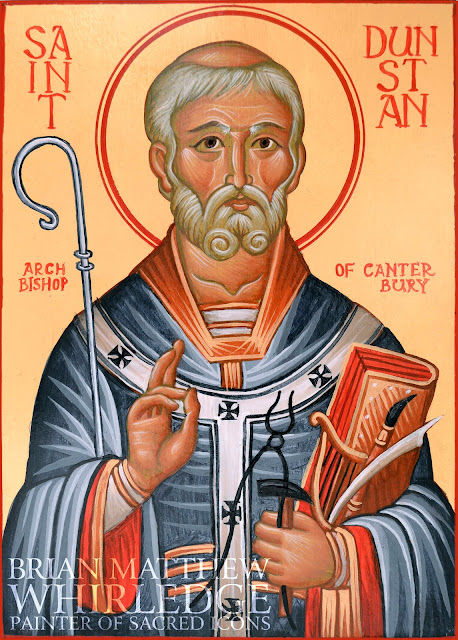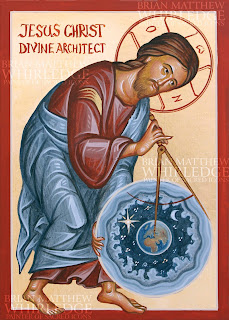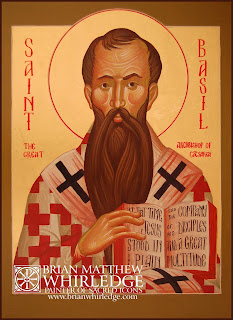Saint Dunstan
St. Dunstan, Archbishop of Canterbury (+988). Acrylic and gold leaf on panel, 8"x10," private commission.
I love Saint
Dunstan and consider him an unofficial patron of my life. I was born on his
feast day, May 19 and have really felt his influence in my life. I feel
very close to him in many ways; we are both English by blood and ecclesiastical
artists and musicians. He lived from 909 to 988 and
I did quite
extensive research for this icon. He is wearing X century English archepiscopal
vestments. English bishops did not wear mitres until XII century. He wears the
pallium (as an archbishop), as well as chasuble, dalmatic, alb, maniple and
amice. As a bishop, he holds his crosier facing outward, shepherding his flock,
as well as holding the Holy Gospel as a teacher. As an artist, he is holding
smithing tongs and hammer, a quill and brush, and a harp. There is a story that
St. Dunstan pinched the devil's nose with red-hot tongs when he tried to tempt
the saint as he was smithing a chalice.
St. Dunstan was from
Glastonbury (home of the Glastonbury Thorn, which grew
from the staff of St. Joseph of Arimathea when he planted staff
in the ground when he evangelized England after the Resurrection of
Christ). He was a monk, abbot, and
bishop, eventually becoming the Archbishop of Canterbury. St. Dunstan led a cultural and monastic
revival in tenth century England, which had been ravaged by the
vikings. He established many monasteries. He encouraged the arts;
Glastonbury became a center of culture. St. Dunstan became Archbishop of
Canterbury, and advised kings (of whom was St. Edward the
King-Martyr).
As a visual artist, St.
Dunstan was an icon painter, he illuminated manuscripts, designed vestments,
cast bells, was a goldsmith and made holy vessels from precious
metals (such as chalices and censers). Below is a manuscript which St. Dunstan
illuminated, and contains a self portrait of the humble Dunstan prostrate at
the feet of the mighty Christ.

In one of his manuscripts, Saint Dunstan left perhaps the earliest self-portrait in history. Source
As a musician, St. Dunstan
composed hymns for the Church. He played on a harp to accompany the nuns
of his abbey as they worked. His dying words were sung from the
Psalms of David. One surviving hymn is "Kyrie Rex
Splendens," which Saint Dunstan, in a vision during Mass, heard
the angels in heaven singing. He quickly wrote it down to preserve
it. It is sung below.
Troparion, Tone 8:
By thee, O Dunstan, hath the whole land of England been wondrously adorned, for thou didst labor unceasingly to restore all the monastic houses laid waste by the heathen, to people them again with zealous monks and nuns, and to provide them with strict rules of pious order wherewith to govern their lives. Wherefore, the Church of Christ doth ever praise thine all-honorable name, O holy bishop.
Kontakion, Tone 3:
Like a master helmsman, O Dunstan, thou didst ably pilot the ship of Church and state in England, skillfully avoiding the treacherous rocks and reefs hidden beneath the tides of thy times, and bringing it safely to the calm harbour of heaven, fully laden with its freight of men's souls, which thou didst deliver, rejoicing, to Christ thy Master.
References
Daniels, R. W. (1987). Dunstan, jewel of the English. Tulsa, OK: St. Dunstan's Press.
Lambertson, I. (n.d.). Service to St. Dunstan. Retrieved from: http://orthodoxengland.org.uk/servduns.htm
Norris, Herbert (2002). Church Vestments: Their Origin and Development. Dover Publications.




Comments
Post a Comment